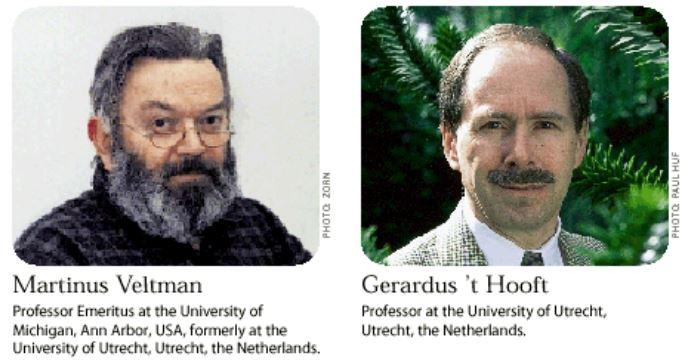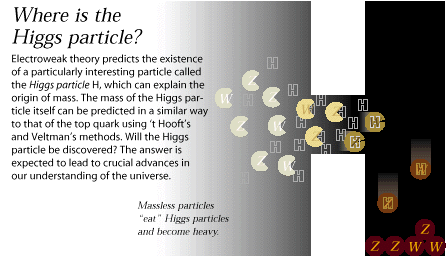Illustrated presentation
The Nobel Prize in Physics 1999
The Royal Swedish Academy of Sciences has awarded the 1999 Nobel Prize in Physics jointly to Professor Gerardus ‘t Hooft and Professor Emeritus Martinus J.G. Veltman for “elucidating the quantum structure of electroweak interactions in physics.”

A theory to reckon with
The structure of particle physics is described using the Standard Model. In this model electromagnetic and weak interactions are unified and together called electroweak interactions. It is theoretical studies of these interactions that have been rewarded with the 1999 Nobel Prize in Physics.

Oven in the sun
The electroweak interactions play an extremely important role in nature. There would be no atoms without electromagnetism and the sun would not shine without weak interactions! Electromagnetic interactions make the electrons keep to their orbits around the nucleus and weak interactions transform protons into neutrons and “bake” them into helium nuclei in the “oven” in the middle of the sun.



‘t Hooft and Veltman did their Nobel Prize work around 1970. Not until results were presented from the particle accelerator LEP at CERN, the European Laboratory in Geneva, was the breadth of their contributions realised. From these results, among other things, the mass of the top quark could be predicted. This prediction was confirmed when the top quark was discovered in 1995 at the Fermi Laboratory outside Chicago.

Further reading
Information on the 1999 Nobel Prize in Physics (press release): The Royal Swedish Academy of Sciences.
Learn more about Particle Physics: www.cern.ch and www.fnal.gov
In search of the Ultimate Building Blocks, by Gerard ‘t Hooft, Cambridge University Press 1997.
The Higgs Boson, by Martinus J.G. Veltman, Scientific American, November 1986, p.88.
Gauge Theories of the Forces between Elementary Particles, by Gerard ‘t Hooft, Scientific American, June 1980, p. 90.
Credits and references for the 1999 Physics Nobel Poster
Editorial Board: Prof. Cecilia Jarlskog, Chair of the Nobel Committee for Physics, and M. Sc. Linda Jarlskog, Lund University, Prof. Anders Bárány, Secretary of the Nobel Committee for Physics, Science Editor Eva Krutmeijer and Dr. Solgerd Björn-Rasmussen, The Royal Swedish Academy of Sciences.
Layout and illustrations: Typoform
Printing: Tryckindustri 1999.
Copyright © The Royal Swedish Academy of Sciences, Information Department, Box 50005, SE-104 05 Stockholm, Sweden, Tel. +46-8-6739500, Fax +46-8-155670, Email: [email protected]
Web adapted version: Nobelprize.org
Every effort has been made by the publisher to credit organizations and individuals with regard to the supply of photographs and illustrations. The publishers apologize for any omissions which will be corrected in future editions.
Nobel Prizes and laureates
Six prizes were awarded for achievements that have conferred the greatest benefit to humankind. The 12 laureates' work and discoveries range from proteins' structures and machine learning to fighting for a world free of nuclear weapons.
See them all presented here.
